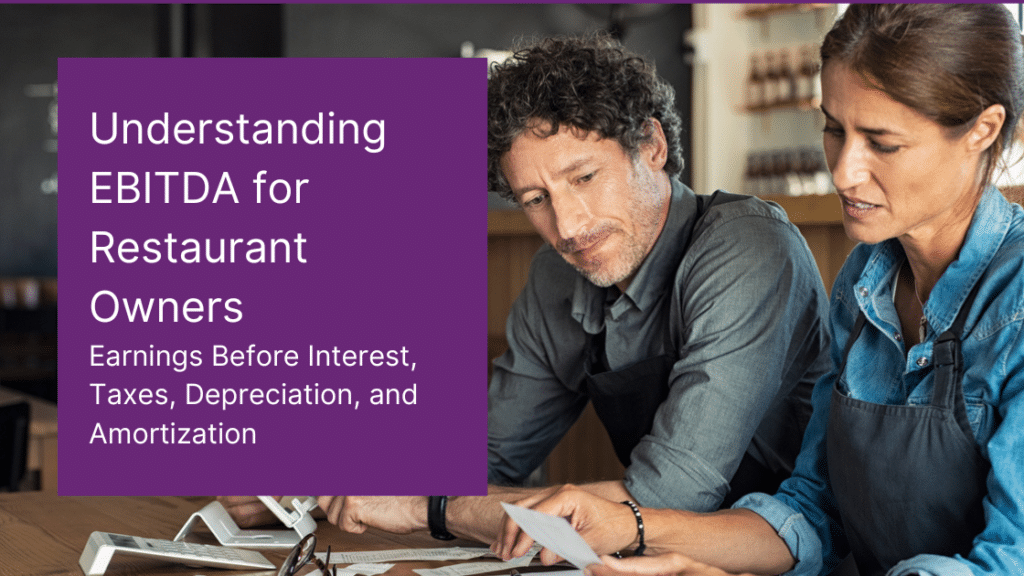Updated on: December 21, 2023
Running a restaurant involves more than just creating delicious dishes and providing excellent service. It’s a complex business requiring keen financial insight. One crucial aspect of this financial landscape is EBITDA – Earnings Before Interest, Taxes, Depreciation, and Amortization. It may sound complicated but, in this chapter we’ll dive deep into what EBITDA is, why it’s important for your restaurant, and how you can use this metric to gauge and improve your business’s financial health.
EBITDA is more than just a jargon-heavy financial term; it’s a clear indicator of your restaurant’s operational performance minus the direct impact of financial and accounting decisions. Understanding EBITDA is vital for restaurant owners, as it provides a more accurate picture of operational profitability, a key to making informed business decisions.
What is EBITDA? Earnings Before Interest, Taxes, Depreciation, and Amortization
EBITDA stands for Earnings Before Interest, Taxes, Depreciation, and Amortization and is a key financial metric that provides a snapshot of a company’s operational profitability. This metric is calculated by adding back interest, taxes, depreciation, and amortization to net income. Essentially, it focuses on the income a business generates from its core operations, making it an excellent tool to compare profitability between companies and industries.
For restaurateurs, EBITDA offers a clear view of their restaurant’s operational efficiency, providing insights into the true earnings potential before the impact of financial and tax considerations. While EBITDA isn’t a measure of cash flow, it remains a powerful tool for assessing operational performance and making informed decisions to ensure sustained financial health in the competitive landscape of the restaurant industry.
Breaking Down the Components of EBITDA
Breaking down EBITDA and its components unveils a clear understanding of the factors contributing to this metric.
Earnings: This represents your restaurant’s net profit, the bottom line of your income statement.
Interest: These are the interest expenses linked to any debt your restaurant has.
Taxes: This includes all the taxes your business pays.
Depreciation: This accounts for the reduction in value of your physical assets (like kitchen equipment and furniture) over time.
Amortization: Similar to depreciation, this deals with the cost of intangible assets (like patents or trademarks) spread over their useful life.
For restaurant owners, comprehending these components is pivotal in interpreting EBITDA. By excluding these elements, EBITDA isolates the operational performance of a business, offering a valuable measure of its ability to generate income from day-to-day activities.
EBITDA vs. Net Income
While both metrics assess profitability, they differ in scope and focus. EBITDA provides a snapshot of operational efficiency by excluding interest, taxes, depreciation, and amortization, offering a purer reflection of core business performance. On the other hand, Net Income reflects the overall profitability after accounting for all expenses, taxes, and interest.
While EBITDA is valuable for assessing operational prowess and cash flow potential, Net Income is a comprehensive measure that considers the broader financial landscape.
Why EBITDA Matters for Restaurants
For restaurants, where operational efficiency is paramount, EBITDA is a critical metric as it offers a transparent view of operational efficiency from day-to-day activities. It helps in understanding how well your restaurant is performing without the influence of external factors like tax rates and interest expenses. This metric is valuable for assessing operational efficiency, cash flow potential, and overall business performance, and is particularly important in the restaurant industry where large capital expenditures and varying tax implications can significantly impact net income.
EBITDA and Investment Decisions
Within the restaurant industry, where strategic decisions shape the trajectory of success, EBITDA holds profound importance, particularly in the context of investment decisions. Investors and stakeholders often look at EBITDA as a way to assess the potential profitability of a restaurant.
A higher EBITDA can indicate a healthy, thriving business, making it more attractive to investors or lenders. It’s also used in valuing your restaurant, as it provides a clearer picture of operating performance and cash flow potential. For restaurant owners seeking investment or contemplating expansion, a robust understanding of EBITDA is not only a financial metric but a strategic tool that influences the attractiveness of their establishments to investors, steering the course of long-term success.
EBITDA in Comparison with Other Industries
EBITDA’s importance lies in its ability to offer a standardized measure of operational profitability by excluding non-operating factors. Unlike industries with less tangible assets, the restaurant industry often deals with significant depreciation and amortization expenses due to equipment and property investments.
Therefore, EBITDA becomes an even more relevant measure for restaurants to accurately reflect operational profitability. The metric’s adaptability allows investors, analysts, and stakeholders to assess and compare the operational efficiency and financial health of restaurants against benchmarks in retail, manufacturing, or technology. As a result, EBITDA serves as a common language in financial analysis, offering a versatile tool for evaluating business performance and making informed decisions, irrespective of the specific industry landscape.
For restaurant owners, recognizing EBITDA’s applicability beyond their sector is key to understanding their position in the broader business environment and strategically navigating the competitive challenges that lie ahead.
Calculating EBITDA for Your Restaurant
Calculating EBITDA for your restaurant is a pivotal step in gaining a nuanced understanding of its operational profitability. The formula involves starting with the net income and adding back interest, taxes, depreciation, and amortization. For a restaurant, this process helps isolate the core earnings generated from daily operations, providing a clearer view of its financial health. Calculating EBITDA might seem daunting, but it’s quite straightforward. Let’s break it down:
Start with Net Profit: This is your starting point, typically found at the bottom of your income statement.
Add Back Interest: Add any interest expenses incurred.
Add Back Taxes: Include all the taxes paid during the period.
Add Back Depreciation and Amortization: These figures are usually found in your financial statements under expenses.
Example Scenarios
Let’s apply this to a common restaurant scenario. Suppose your annual net profit is $100,000, interest expenses are $5,000, taxes paid amount to $15,000, and depreciation plus amortization expenses are $10,000. Your EBITDA would be $130,000.
The result is a figure that reflects the restaurant’s ability to generate income from its primary activities, excluding non-operating factors. This calculation not only aids in internal financial analysis but also serves as a valuable metric for potential investors, stakeholders, and industry comparisons.
Tools and Software for EBITDA Calculation
Leveraging advanced tools and software for EBITDA calculation streamlines the process and enhances accuracy. Modern accounting software, financial management platforms, and enterprise resource planning (ERP) systems often come equipped with features that facilitate the automatic computation of EBITDA.
Several accounting software programs can automate this calculation, ensuring accuracy and saving time. These tools eliminate the manual effort involved in gathering data and performing calculations, reducing the risk of errors and ensuring efficiency in financial reporting. Additionally, customized spreadsheets and financial modeling software can be tailored to automate the EBITDA calculation, providing restaurateurs with a dynamic and adaptable solution.
Interpreting Your EBITDA
Interpreting your EBITDA is a crucial skill for restaurateurs seeking a deeper understanding of their business’s financial landscape. A “good” EBITDA varies across the restaurant industry, depending on factors like location, size, and type of cuisine. Generally, a higher EBITDA margin (EBITDA as a percentage of revenue) indicates better operational efficiency and profitability. This metric offers a clear view of the core income derived from day-to-day operations.
A consistently positive EBITDA indicates operational efficiency and robust financial health, showcasing the restaurant’s ability to cover operating costs and generate earnings. However, it’s essential to interpret EBITDA in conjunction with other financial metrics, considering its limitations, such as not accounting for capital expenditures or changes in working capital. Industry benchmarks can provide a comparative standard, but it’s essential to consider your unique business context.
Common Misinterpretations of EBITDA
While EBITDA is a useful metric, it’s not a one-size-fits-all indicator and common misinterpretations can arise, potentially leading to inaccurate conclusions about a restaurant’s financial health. One prevalent misunderstanding is viewing EBITDA as a direct representation of cash flow, which it is not, as it excludes crucial elements like capital expenditures and changes in working capital.
Another pitfall is solely relying on EBITDA for financial assessments without considering the broader context, industry benchmarks, or specific business nuances. It’s crucial to recognize that EBITDA doesn’t account for debt obligations or interest expenses, and its interpretation should be complemented by a comprehensive analysis of the restaurant’s overall financial landscape.

Improving Your Restaurant’s EBITDA
Improving your restaurant’s EBITDA involves a strategic focus on operational efficiency and revenue optimization. Begin by identifying and addressing cost drivers, implementing measures to control expenses without compromising quality. Streamlining inventory management to minimize waste, negotiating favorable supplier contracts, and optimizing staffing levels for peak efficiency are critical steps. Introduce menu engineering to highlight high-margin items and eliminate underperforming ones.
Embrace technology solutions for enhanced data visibility and financial control. Additionally, explore opportunities for revenue growth through targeted marketing, promotions, and diversification of offerings. Regularly monitor and analyze financial performance to identify trends and proactively address challenges. Here are other ways that restaurateurs can pave the way for a positive EBITDA:
Increasing Earnings
Improving your restaurant’s EBITDA involves a targeted approach to increase earnings, enhancing the operational efficiency that drives profitability. Boosting revenue is the most straightforward way to improve your EBITDA. This can be achieved through various strategies like menu optimization, marketing promotions, and enhancing customer experience to encourage repeat business. Effective pricing strategies aligned with market trends and consumer preferences can enhance revenue streams without compromising customer satisfaction.
Additionally, exploring catering services, partnerships, or online sales channels can open new avenues for income. By consistently identifying opportunities for revenue growth and aligning them with the unique strengths of your restaurant, you can not only enhance your EBITDA but also foster long-term financial sustainability.
Managing Expenses Wisely
A pivotal aspect of enhancing your restaurant’s EBITDA lies in prudent expense management; Careful cost control is critical. Conduct a thorough analysis of operational expenses, identifying areas for optimization. Regularly review supplier contracts, minimize waste, and optimize labor costs.
Embrace technology for efficient financial tracking and control. Consider energy-efficient appliances, minimizing food waste, optimizing the use of resources and other cost-saving measures in your operation can further contribute to lowering operational costs.
Investment and Cost Efficiency
Improving your restaurant’s EBITDA involves a balanced focus on strategic investments and cost efficiency. Invest strategically in areas that will yield high returns, like technology that improves service speed, renovating the dining space for enhanced customer experience, or investing in marketing campaigns to attract a broader audience. Assess potential areas for investment that align with your business goals and have the potential to drive revenue growth.
Simultaneously, emphasize cost efficiency by optimizing operational processes, negotiating favorable supplier agreements, and implementing energy-saving measures. Striking a careful balance between investment and cost management ensures that every expenditure contributes positively to the restaurant’s financial health. However, be cautious about over-investing in areas with long payback periods.
Limitations of EBITDA
While EBITDA is a valuable metric for assessing operational profitability, it comes with inherent limitations that necessitate a nuanced interpretation. One major constraint is its exclusion of crucial elements such as interest, taxes, and non-cash expenses like depreciation and amortization. This exclusion makes EBITDA an incomplete measure of a business’s overall financial health, as it doesn’t account for debt obligations or changes in working capital.
As a result, EBITDA should be considered alongside other financial metrics to provide a comprehensive view. While it offers insights into operational efficiency, its limitations underline the importance of a holistic financial analysis for making informed decisions and understanding the complete financial picture of a restaurant or business. Here are other limitations that you should take into consideration:
The Blind Spots of EBITDA
Despite its widespread use as a financial metric, EBITDA carries inherent blind spots that require careful consideration. One prominent limitation lies in its exclusion of interest, taxes, and non-cash expenses like depreciation and amortization, offering an operational view without a complete financial picture. EBITDA does not account for cash flow, which is vital for the day-to-day operation of your restaurant.
This omission can mask a business’s true financial health and sustainability, as it neglects vital elements such as debt obligations and changes in working capital. It also overlooks capital expenditures, which are significant in the restaurant industry. Therefore, while EBITDA serves as a valuable tool for operational insights, understanding its limitations is crucial.
Complementary Financial Metrics
While EBITDA provides valuable insights into a business’s operational profitability, its limitations underscore the importance of considering complementary financial metrics for a more comprehensive evaluation. To get a comprehensive financial picture, combine EBITDA with other metrics like net income, cash flow statements, and return on investment (ROI).
Net income captures a more complete picture of profitability, considering all expenses and taxes. Cash flow metrics provide insights into a business’s liquidity and ability to meet financial obligations. Return on investment helps assess the profitability of capital deployed. This holistic approach will provide a more accurate assessment of your restaurant’s financial health.
EBITDA in the Context of COVID-19
The COVID-19 pandemic has cast a profound impact on businesses worldwide, and EBITDA has played a crucial role in navigating the financial challenges brought about by this unprecedented situation. In the context of the pandemic, EBITDA has served as a vital metric for assessing a company’s operational efficiency and resilience. As businesses faced disruptions, lockdowns, and shifts in consumer behavior, EBITDA provided a clear picture of how well they were able to generate earnings from core operations.
However, the pandemic has also highlighted the importance of considering additional financial metrics and adjusting EBITDA interpretations to account for extraordinary circumstances. Businesses that have weathered the storm effectively have often adopted a more comprehensive financial analysis approach, incorporating liquidity metrics, cash flow considerations, and scenario planning alongside EBITDA. In the ever-evolving landscape shaped by the pandemic, EBITDA remains a valuable tool, but its application requires a nuanced understanding and adaptation to the unique challenges posed by global crises.
The Pandemic’s Financial Impact on Restaurants
COVID-19 has drastically altered the financial landscape for restaurants. Restaurants faced closures, capacity restrictions, and shifts in consumer behavior, leading to a seismic disruption in their revenue streams. EBITDA, while traditionally a valuable metric for operational profitability, has encountered new complexities in this tumultuous environment. The pandemic has underscored the need for businesses, especially in the restaurant sector, to adapt EBITDA analyses to reflect the extraordinary circumstances.
Comprehensive financial assessments that integrate liquidity considerations, cash flow management, and scenario planning have become essential for a more accurate understanding of a restaurant’s financial health. EBITDA, though vital, now requires a contextual interpretation that accounts for the unique challenges imposed by the ongoing pandemic, providing restaurateurs with a more nuanced perspective to navigate the ever-evolving landscape of the hospitality industry. Understanding how these changes affect your EBITDA is crucial for accurate financial planning post-pandemic.
Adjusting EBITDA Calculations
Restaurants, in particular, since COVID-19 have faced unparalleled challenges, requiring a nuanced approach to EBITDA calculations. The pandemic has prompted businesses to adjust their interpretations of EBITDA to account for extraordinary circumstances, such as government-mandated closures, reduced capacities, and shifts in consumer behavior.
Consider the temporary or permanent changes in your business model, like increased reliance on delivery services, and how these impact your operational costs and revenue streams. Adjustments may include factoring in government assistance programs, accounting for changes in cost structures, and incorporating scenario planning for various recovery timelines. Adjust your EBITDA calculations to reflect these new realities.
As we’ve seen, EBITDA is more than just a financial metric; it’s a vital tool for understanding and improving the operational health of your restaurant. By accurately calculating and interpreting EBITDA, you can gain valuable insights into your business’s profitability and make more informed decisions. Remember, while EBITDA is an important indicator, it should be used in conjunction with other financial metrics to get a complete picture of your restaurant’s financial standing.
In challenging times, adapting and understanding the nuances of EBITDA becomes even more critical. As you navigate the evolving landscape of the restaurant industry, keep this guide in mind to help steer your financial strategy toward sustainable growth and success.
Stay on Top of Your Restaurant Analytics with SynergySuite
Being able to readily stay on top of your data, and make informed decisions based on that data, it’s absolutely critical to have implemented a quality restaurant reporting and analytics platform like SynergySuite.
Many of the problems and challenges of running a restaurant can be solved or avoided with the right restaurant reporting tools. We offer restaurant analytics software that captures and presents your data in an easy-to-understand dashboard. We make it simple to use your valuable data to save time, improve profitability, and ensure compliance with regulations.
Schedule a demo today to see how SynergySuite can help you take your restaurant business to the next level.






